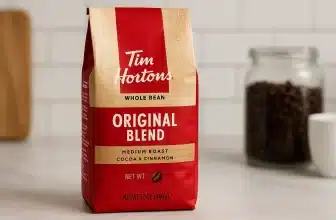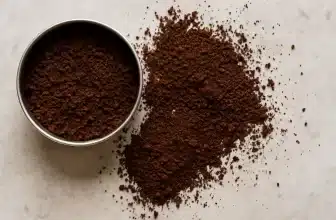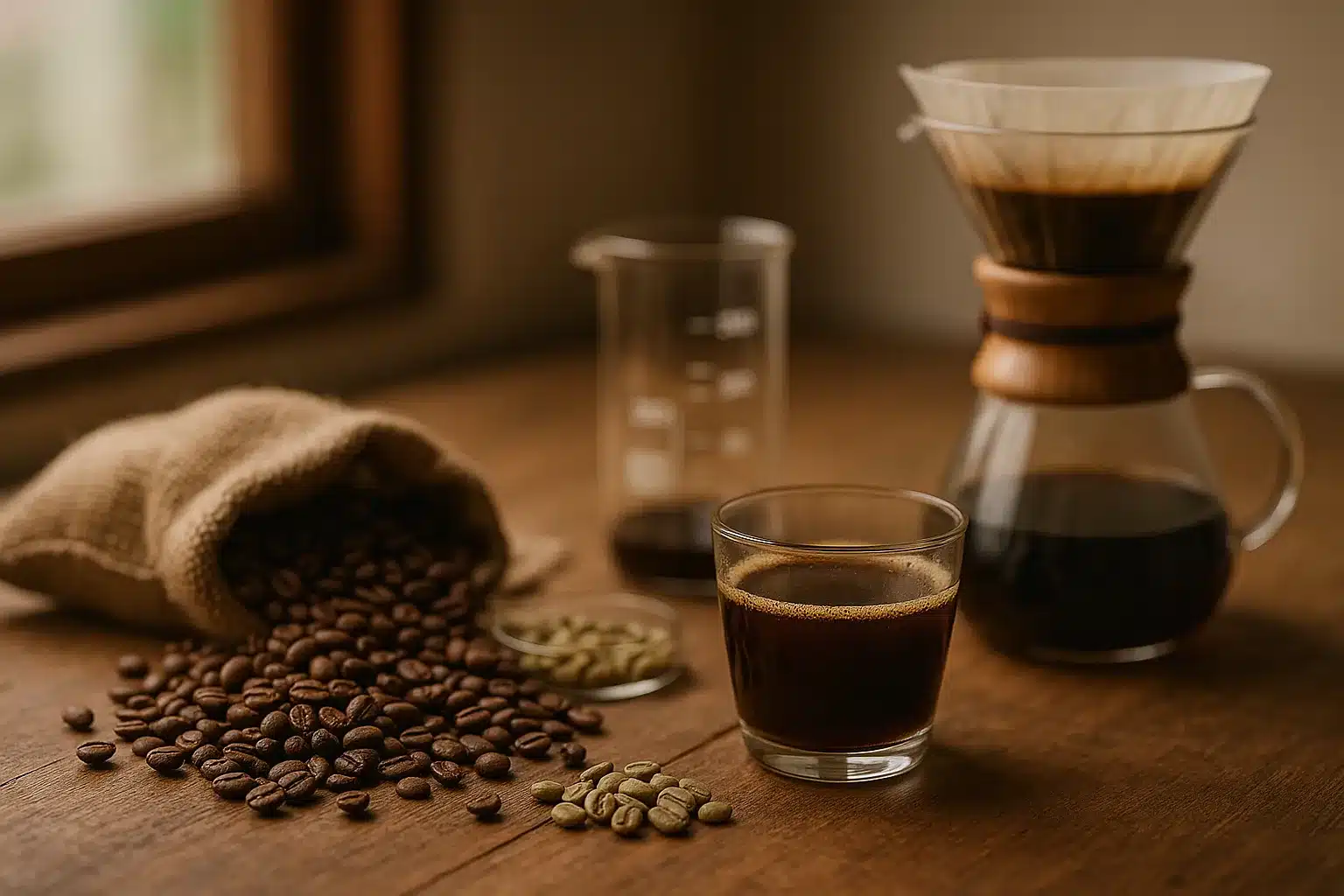
OneHundredCoffee is reader-supported, and some products displayed may earn us an affiliate commission. Details
The first decaf that ever surprised me tasted like ripe plum and milk chocolate. It was a late-night espresso at a friend’s roastery—no caffeine jitters, no “cardboard aftertaste,” just a balanced cup that could have passed for a favorite house blend. That shot changed how I think about decaf. It wasn’t a consolation prize; it was simply coffee—treated carefully before, during, and after the decaffeination step. If you’ve been curious about what decaffeination actually does to coffee and why some decafs taste flat while others sing, let’s take a friendly, practical walk through the science, the craft, and the cup.
This guide breaks down how caffeine is removed, what that means for bean structure and roasting, how flavor is shaped (and sometimes lost), and what you can do at home to make decaf taste bright, sweet, and satisfying. Along the way, I’ll share real-world tips that have helped me dial in better decaf brews—whether you’re aiming for pour-over clarity, a silky immersion, or a dependable espresso after dinner.
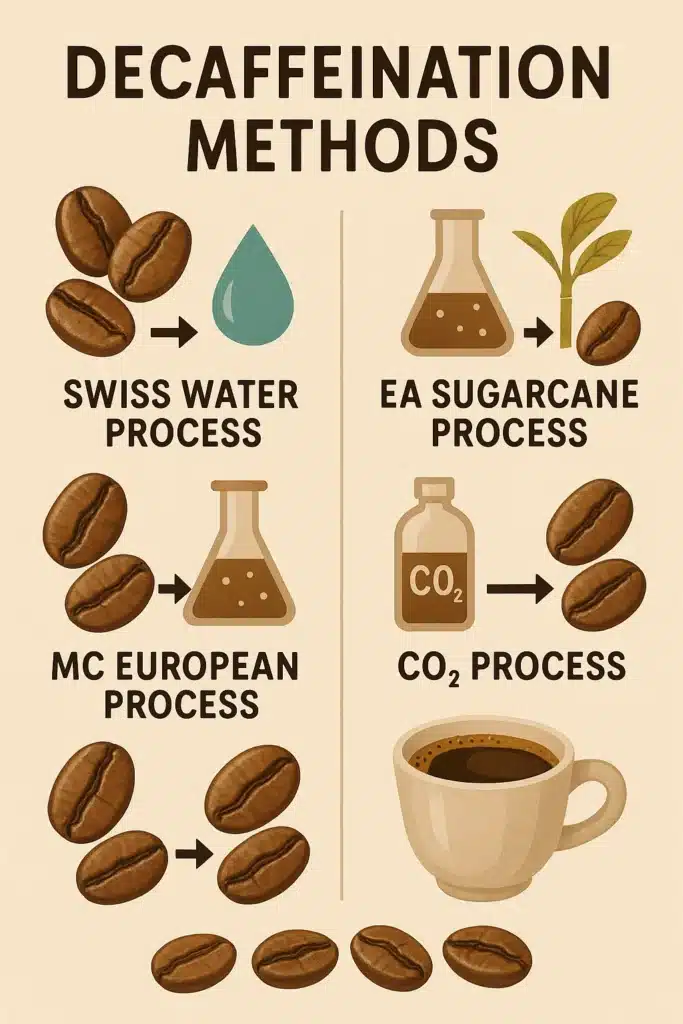
Why Decaf Tastes Different (And Why It Doesn’t Have To)
Coffee flavor comes from hundreds of aromatic compounds formed during roasting and expressed during brewing. The big twist with decaf is that the beans are processed before they ever enter the roaster. To remove caffeine, we have to open the door to the seed’s interior—using water, solvents, or supercritical CO₂—so caffeine can be coaxed out. That pre-roast treatment changes moisture balance, cell structure, and the fate of some precursors that would later become aromatics in your cup. It’s a bit like marinating a steak before cooking: you can improve tenderness and infuse flavor, but you can also overdo it and change the texture.
Historically, decaf often got a bad rap for two reasons that had nothing to do with the method itself: lower-grade green coffee was sometimes used, and roasting targets were not always adjusted for how decaf behaves in the drum. Today, with better green selection and roast profiles designed specifically for decaf’s quirks, you can find cups that are clean, sweet, and distinct—fruity naturals, silky lactic profiles, chocolate-forward espressos, even floral Ethiopians that keep their lift.
A Quick Primer: What Decaffeination Actually Does
Caffeine is a small, water-soluble molecule. Decaffeination works by swelling the green beans (usually with water) so caffeine can be extracted while trying to keep other desirable flavor precursors in place. The trick is selective removal. Every method is a balancing act between getting caffeine out efficiently and leaving as much of the coffee’s potential as possible.
A few practical truths are helpful to hold in your mind:
- Decaf beans typically arrive at a roaster darker green to brownish compared to regular green coffee because they’ve been pre-soaked or treated.
- They often roast faster. First crack can arrive earlier, and color can deepen more quickly.
- They can be more brittle. Gentle handling in storage and roasting helps.
- Quality matters everywhere: ripeness, processing on the farm, decaf method, and a roast designed for decaf all stack together to decide your final cup.
The Main Decaffeination Methods and Their Flavor Signatures
Swiss Water Process (Water + Carbon Filtration)
Swiss Water relies on water and a “green coffee extract” saturated with soluble coffee compounds but not caffeine. Fresh green beans are soaked in this extract; because the liquid already contains everything except caffeine, the osmotic pull selectively draws caffeine out of the beans. The caffeine is then caught on carbon filters, and the extract is reused. The promise is simple: remove caffeine without introducing foreign solvents.
In the cup: When handled well, Swiss Water decafs are known for clean sweetness and good origin transparency. For washed-origin lovers—Ethiopia, Kenya, Colombia—this is often the gateway to decaf that still tastes like the place it came from. I’ve found Swiss Water naturals can keep their berry tones too, minus the boozy edges that sometimes show up elsewhere.
What to expect: Balanced sweetness, less “hollow” mid-palate than older-school decafs, and a finish that doesn’t fall apart as the cup cools.
Ethyl Acetate (EA), Often Called “Sugarcane Process”
Ethyl acetate occurs naturally in fruits and can also be produced for industrial use. In this method—popular in Colombia—beans are steamed to open pores, then washed with EA so caffeine binds and can be removed. Afterward, beans are steamed again to evaporate residual EA and re-dried.
In the cup: Many EA decafs present with a caramel–toffee sweetness and a soft, approachable acidity. I’ve had sugarcane decafs that made dreamy dessert espressos: cocoa, dulce de leche, roasted almond, and a gentle fruit whisper rather than a shout.
What to expect: Comforting flavor, rounded texture, and excellent versatility for drip or espresso when you want “chocolate and nuts” more than perfumed florals.
Methylene Chloride (MC), Sometimes Labeled “European Process”
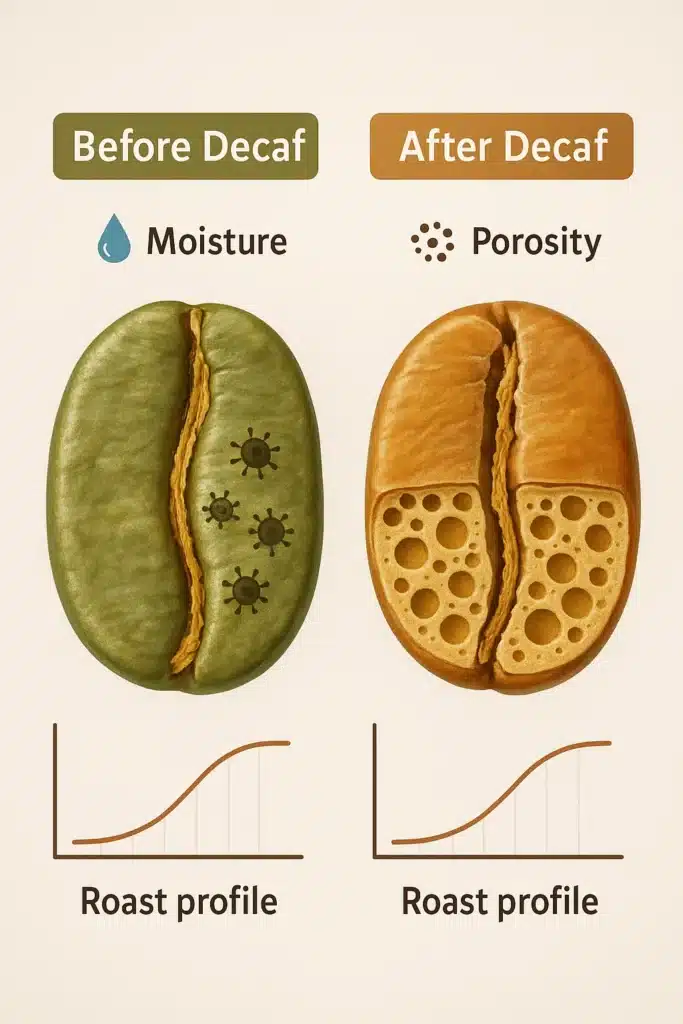
With methylene chloride, beans are moistened and washed with MC so caffeine dissolves into the solvent. The beans are then extensively rinsed and dried. The method aims for high efficiency with minimal loss of flavor compounds. When correctly executed, residual solvent levels after processing are below strict safety thresholds, and MC volatilizes at roasting temperatures.
In the cup: A good MC decaf can be surprisingly nuanced—clean sweetness and origin character that’s closer to the caffeinated version than many expect. In my brews, the best examples give a very “normal coffee” experience: chocolate, gentle fruit, tidy finish.
What to expect: A familiar flavor profile with good clarity when the green is high quality and the roast is attentive.
Supercritical CO₂
Under high pressure and specific temperature, CO₂ becomes supercritical—behaving like both a gas and a liquid—with a strong affinity for caffeine. Beans are exposed to this CO₂, caffeine dissolves into it, and then it’s separated and recovered. Because CO₂ is selective for caffeine, there’s potential for excellent flavor retention.
In the cup: When you find it, CO₂ decaf can be very clean and sweet, with a natural-tasting structure. I’ve tasted bright pour-overs and tidy espressos that felt “un-decaf” in the best way—lively acidity, no papery edges.
What to expect: Subtlety and cleanliness; a good match for people who obsess over clarity in washed coffees.
What the Process Does to the Bean Itself
Moisture and Porosity
Decaffeination typically swells beans with water or steam before extraction. Afterward, they’re dried back down. This cycle changes the internal cell walls and increases porosity. More porous beans roast differently: heat moves faster, and the pathway to first crack can feel “greased.” That’s why decaf can darken quickly and why a roaster who treats decaf exactly like regular coffee often overshoots.
Color Before Roasting
Fresh green coffee is usually a pale jade color. Decaf green often looks more khaki or cinnamon-brown because of the pre-soak and chemical interaction with the seed. That color difference doesn’t mean it’s roasted—just that it’s taken a detour on the way to the drum.
Fragility
Repeated wetting and drying can make beans more brittle. You’ll sometimes see more chaff and a few more broken beans. A conscientious roaster will adjust drum speed, batch size, and airflow to treat decaf gently.
How Decaf Changes the Roaster’s Job
Roasting decaf is less about “what can I get away with?” and more about “how do I protect what’s left?” Here are patterns I’ve seen across well-roasted decafs:
- Lower charge or gentler early energy: Because decaf accelerates, many roasters ease off the throttle at the start to avoid scorching the exterior while the interior is still cool.
- Watch first crack: It often arrives earlier and louder. Extending development too long can push decaf into a burned-sugar zone quickly.
- Aim for sweetness, not bravado: The best decaf roasts build a caramel backbone without erasing top notes. When I cup decaf roasts that shine, they often show medium development with a crisp, not ashy, finish.
If you’ve ever wondered why one roaster’s decaf tastes vibrant and another’s tastes dull, roast strategy is usually a big part of the answer.
What You’ll Taste: Typical Flavor Differences by Method
Taste is never a law, but patterns help when you’re shopping:
- Swiss Water: Clean sweetness and origin clarity. Think citrus and florals for washed Ethiopians; milk chocolate and red apple for many Colombians; tidy nuttiness in Brazils with less papery finish than old-school decaf.
- EA (Sugarcane): Caramelized sweetness, round acidity, friendly textures. Great if you like hot cocoa, praline, and gentle fruit.
- MC (European): “Just coffee” done well—balanced, familiar, often surprisingly close to its caffeinated sibling when the green is high quality.
- CO₂: Crisp and clean, often with bright edges preserved; a solid match for pour-over people who crave clarity.
Brewing Better Decaf at Home
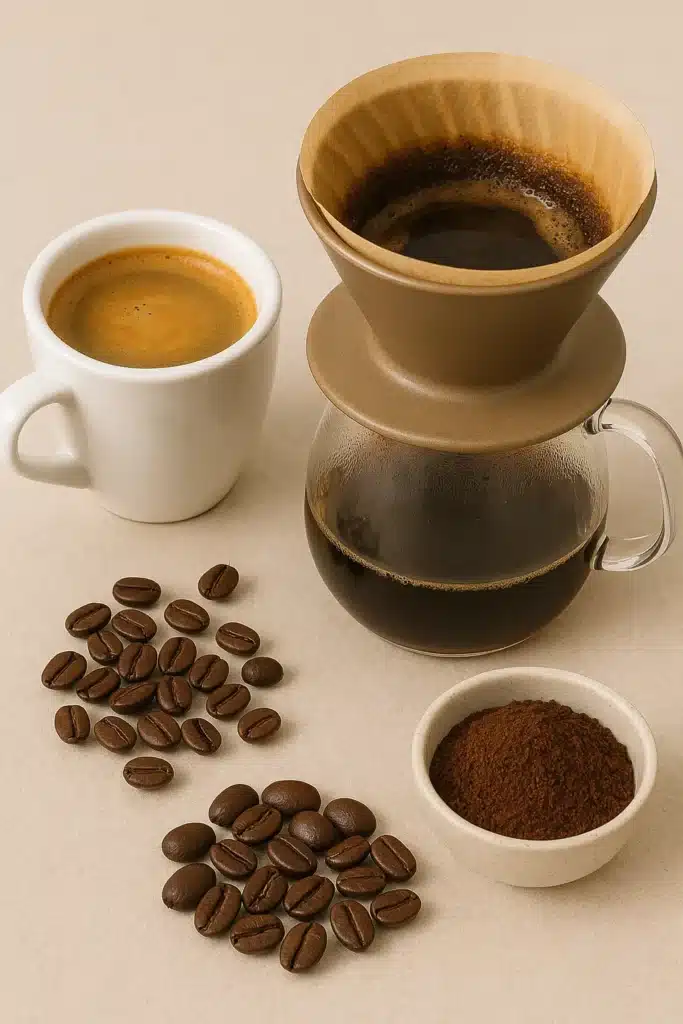
Here’s where decaf gets personal. Because the bean has been through extra handling, the brew can benefit from minor tweaks that respect its changed structure.
Grind and Flow
Decaf’s increased porosity can be extracted a little faster. If your decaf pour-over is draining too quickly and tasting thin, go slightly finer. If the shot races on espresso, reduce the dose a hair or grind finer to restore resistance—but be gentle: decaf pucks can channel if you push too far. I’ve had success giving decaf pucks a touch longer pre-infusion to saturate evenly before full pressure.
Brewing Temperature
For bright, washed decaf, brewing a degree or two warmer can wake up aromatics. For caramel-forward EA decafs or darker roasts, dropping a degree can tame bitterness and preserve sweetness. Small changes make big differences here.
Ratio and Contact Time
If a decaf tastes hollow at your standard ratio, try a slightly higher dose or a bit longer contact time to build mid-palate weight. Conversely, if a natural decaf reads boozy or heavy, lighten the dose and shorten the contact slightly to keep it playful.
Bloom and Degassing
Decaf sometimes blooms less dramatically, which can tempt you to skip the bloom altogether. I still recommend a short bloom to equalize the temperature and start extraction evenly. Fresh decaf benefits from that little head start; older decaf appreciates the gentle awakening.
Espresso With Decaf: Dialing for Sweetness, Not Stubbornness
The best decaf espressos I’ve pulled have been built on patience, not force. I like to start with ratios in the neighborhood of 1:1.8–1:2.2, aim for 25–32 seconds from first drip, and tweak the grind to land sweet. I prefer gentle pre-infusion or a softer ramp to pressure, especially with single-wall baskets, because it reduces early channeling. If you get a hollow, watery shot, try bumping the dose up 0.5–1 gram or tightening the grind slightly; if you get harshness, lower brew temp 1–2°C or extend pre-infusion. Decaf blends with a little natural-process component often shine here—cocoa sweetness with a raspberry or dried fruit lift.
Cold Brew and Iced Decaf: Why It Works So Well
Cold water extraction is forgiving with decaf. Even when hot brews taste a touch flat, cold brew can coax out chocolate, hazelnut, and brown-sugar notes without pressing bitterness. I’ve had EA decaf make knockout iced Americanos too, where the caramel notes ride comfortably over ice. If you want a “summer decaf,” try a medium roast Colombian EA or a Swiss Water Brazil for cold brew, and keep the steep around 12–16 hours in the fridge. You’ll get plush sweetness and a finish that doesn’t go sour when diluted.
How Much Caffeine Remains?
Decaf is typically at least ninety-something percent caffeine removed—often quoted around the “97%+ removed” range. What matters practically is that a cup of decaf contains only a fraction of the caffeine you’d find in regular coffee. If you’re highly sensitive, keep in mind “decaffeinated” isn’t “zero,” but for most people it means late-night coffee without sleep penalties. Blends and preparation style (espresso vs drip) can shift the actual milligrams in your cup.
Choosing a Decaf You’ll Love
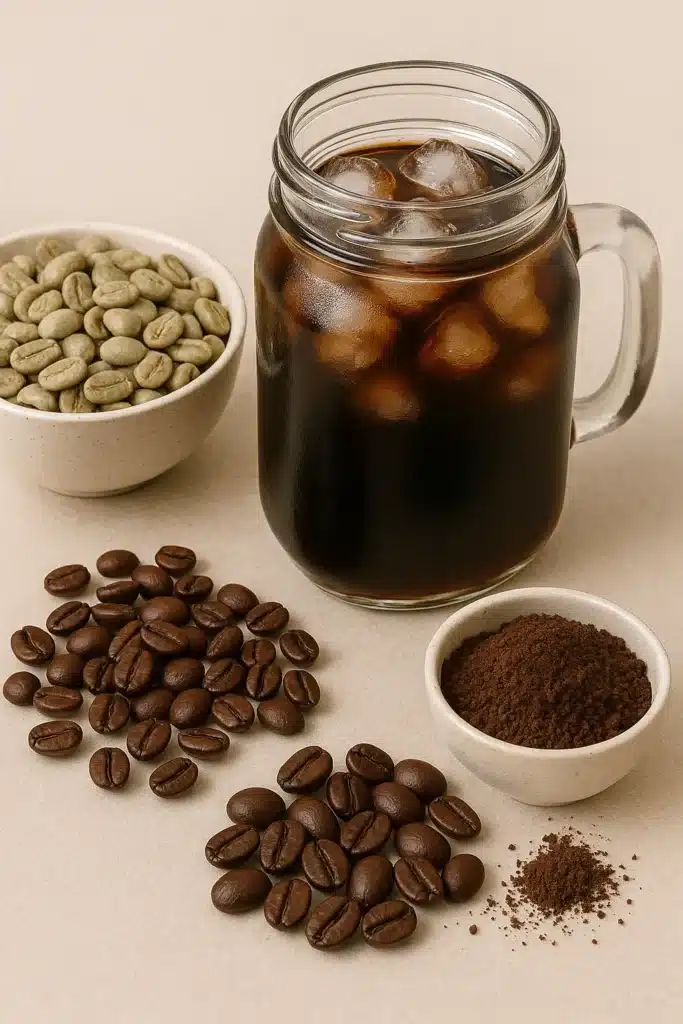
Start with the flavors you already like in regular coffee and pick the decaf process that tends to preserve those qualities.
If you enjoy clean floral and citrus notes, try a Swiss Water or CO₂ decaf from East Africa or a washed Colombian. For comforting flavors of chocolate, caramel, and nuts, EA decaf is a great choice. Espresso lovers looking for “house blend” vibes with less intensity will appreciate MC decafs from trusted roasters, which often provide that classic profile.
Origin still matters. A decaf Yirgacheffe won’t suddenly taste like a Sumatran just because caffeine left the scene. You’ll get the same origin architecture, just a softer energy and sometimes a shift in the way sweetness presents.
Storage and Freshness: Treat Decaf Like a Delicate Perfume
Store beans in a cool, dark place, sealed tightly. If you won’t finish a bag within two to three weeks, portion and freeze in airtight containers. Grind from frozen if you like; it can preserve aromatics beautifully, especially for decafs that lean floral. Decaf tastes like regular coffee, and sometimes faster if the roast was pushed. If your decaf seems to fade quickly, try freezing it soon after opening and pulling just what you need.
Troubleshooting Common Decaf Problems
If your pour-over tastes papery or thin, first check your filter rinse and brew ratio. Then tighten the grind a notch and raise the brew temp 1°C. If your espresso is harsh or astringent, consider a lower brew temp, finer grind with a shorter ratio, or longer pre-infusion. If a natural decaf reads funky or boozy, open the grind a touch and shorten contact time; aim for clarity rather than weight.
Sometimes the fix is simpler: try a different decaf method. If you’ve only had EA decaf and want more sparkle, grab a Swiss Water Ethiopia. If you’ve only had naturals, try a washed CO₂ decaf for a reset. The method is a flavor dial—turn it.
The Economics of Good Decaf (And Why It’s Worth It)
Decaffeination is expensive and logistically complex. Moving coffee to a decaf plant, processing it, moving it again, then roasting and distributing means more steps where quality can improve—or degrade. That’s why better decaf often costs a little more. You’re paying for careful green selection and a roaster who built a profile specifically for decaf instead of just turning the roast curve down and hoping. If you drink decaf regularly, it’s worth supporting the people doing it right. Your nightly espresso will thank you.
Best 3–5 Amazon-Available Picks to Explore Great Decaf
Kicking Horse Coffee — Decaf (Swiss Water Process)
This is a friendly, chocolate-forward introduction to decaf that still carries a pleasant fruit lift. Brewed as a drip or French press, it’s comforting without being dull, and it makes a forgiving espresso when you want a creamy cappuccino at night.
Stumptown Coffee Roasters — Trapper Creek Decaf (Swiss Water Process)
A benchmark for clean, modern decaf. Expect cocoa and baked apple with a refined finish that holds up as it cools. I’ve enjoyed it most as V60 and as a mellow espresso pulled a touch longer.
Peet’s Coffee — Decaf Major Dickason’s Blend
Classic, robust, and reliable. If you like a fuller roast profile and want that “just coffee” satisfaction, this delivers a deep, toasty sweetness that works across drip machines and moka pots.
Lavazza — Decaffeinated Espresso
An accessible choice for espresso machines and stovetop brewers. Think smooth crema, cocoa, and roasted hazelnut. It pairs beautifully with milk without disappearing.
Volcanica Coffee — Costa Rica Decaf Tarrazu (Swiss Water Process)
Balanced and sweet with citrus brightness and milk-chocolate depth. It’s an excellent example of decaf that still tastes like a specific place and altitude, not just “generic decaf.”
(Availability can vary by season and roast date, but these product names are commonly listed on Amazon and make excellent starting points for tasting how the process shows up in the cup.)
FAQs People Ask About Decaf (Answered Plainly)
Is decaf safe?
Yes. When performed to modern standards and roasted normally, decaf coffee is considered safe to drink. The decaf step itself is followed by thorough drying and, later, a roast that drives off residual volatiles.
Does decaf taste weaker because it has less caffeine?
Caffeine doesn’t contribute much to flavor strength. Weakness usually comes from extraction choices or from decaf beans roasted without adjustment. With a good roast and a well-dialed brew, decaf can taste just as “full” as regular coffee.
Which method tastes best?
“Best” depends on what you enjoy. For clarity and origin nuance, many people gravitate to Swiss Water or CO₂. For comforting sweetness and an easy espresso, EA is excellent. MC can be very balanced and familiar. Try two methods side by side to discover your preference.
Is decaf more acidic on my stomach?
Perceived acidity in taste is not the same as stomach acidity. Roast level and brewing parameters often affect comfort more than the decaf method. If you feel sensitive, try a medium roast decaf brewed with a slightly lower water temperature and see how it sits.
Why does my decaf espresso channel so easily?
Decaf’s altered cell structure can make pucks fragile. A finer grind plus longer pre-infusion, gentle distribution, and careful tamping help. Consider a slightly higher dose to improve resistance if shots gush.
How to Taste Decaf Like a Pro (At Home)
A simple experiment reveals a lot. Brew a washed Swiss Water Colombia and an EA Colombia back to back at the same ratio and temperature. Taste hot, then as they cool. You’ll probably find the Swiss Water holds a brighter line with citrus or apple, while the EA leans to caramel and cocoa. Switch brewers—pour-over vs immersion—and see how texture and sweetness shift. Write down three words for each cup. This small ritual teaches your palate how process shapes flavor, so your next bag purchase is guided by experience rather than guesswork.
When Decaf Shines the Brightest
There’s something special about a late-night coffee ritual that doesn’t nudge your sleep. Decaf cappuccinos after dinner, a pour-over during a creative midnight sprint, a calm Sunday morning second cup without the jitters—these are decaf’s sweet spots. I reach for decaf when I want the comfort and craft of coffee without the edge, and I reach for better decaf when I want that comfort to taste like a place I’d love to visit: a hillside in Huila, a drying patio in Tarrazú, a washing station in Sidama.
Final Thoughts: Decaf That Tastes Like Coffee
Decaffeination doesn’t have to be a flavor tax. It’s just another step where choices matter. Choose a decaf method that suits your palate. Choose roasters who roast decaf like they mean it. Brew with small, thoughtful adjustments. When all those choices line up, decaf becomes what it should have been all along: coffee that fits your life, at any hour, with flavors you’re excited to taste again tomorrow.
If your last decaf was underwhelming, consider this your invitation to try again. Start with a Swiss Water or CO₂ option if you love clarity. Try an EA decaf if you crave caramel and cocoa in milk drinks. Keep notes, tweak one variable at a time, and watch your nighttime coffee routine go from “fine” to “favorite.”





